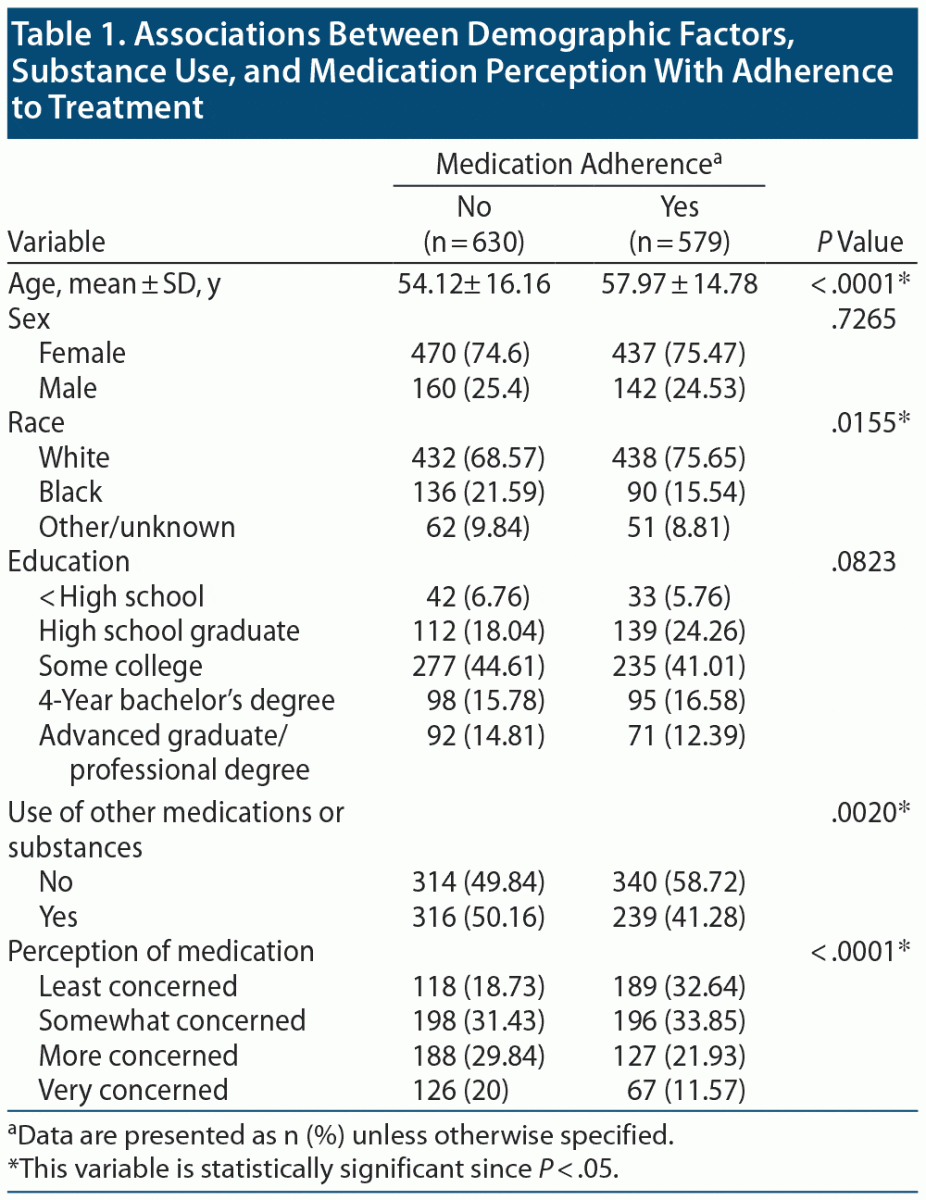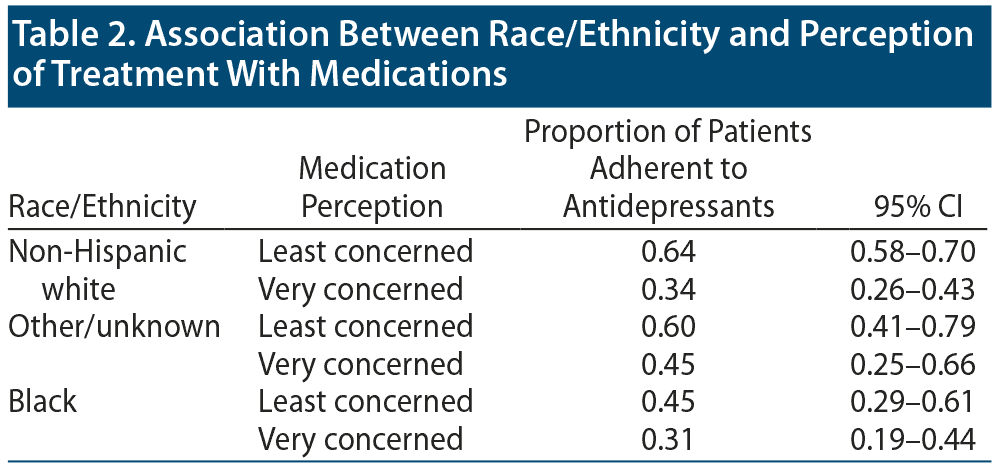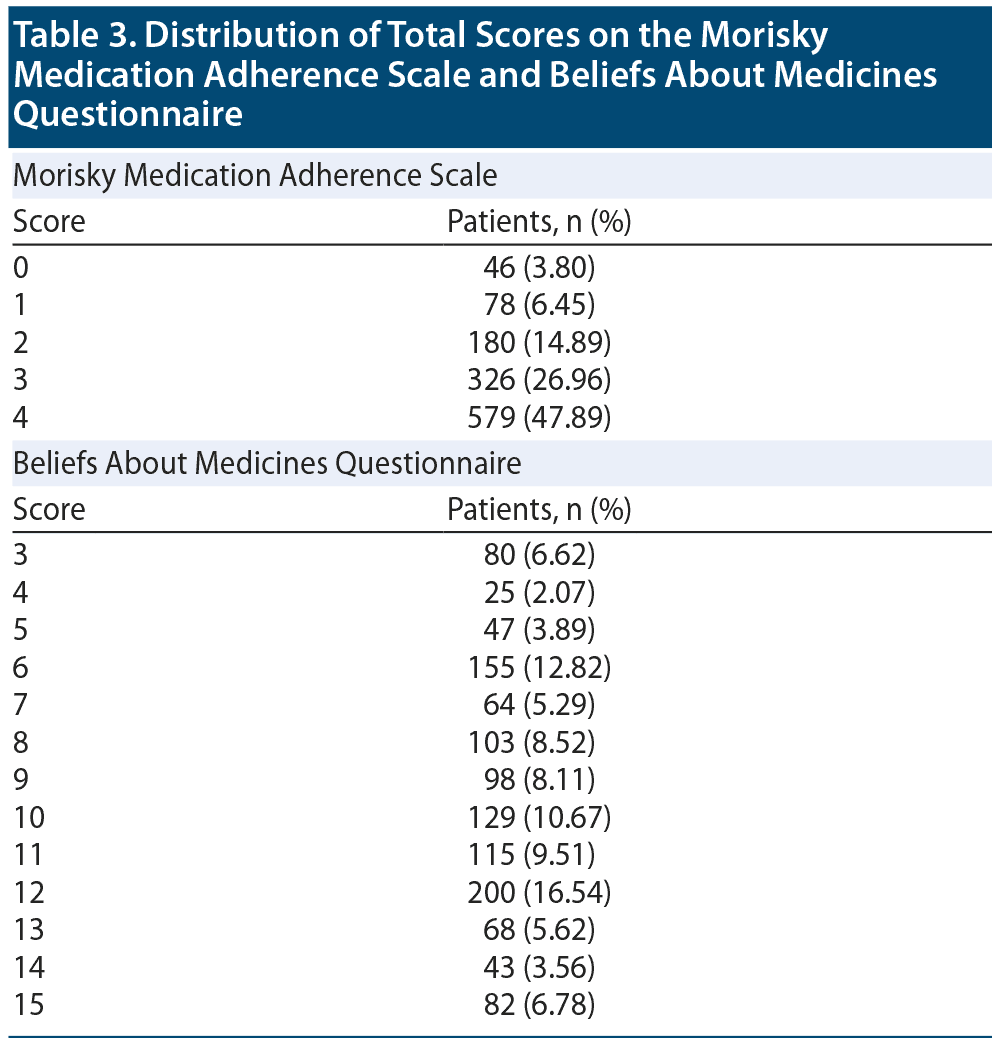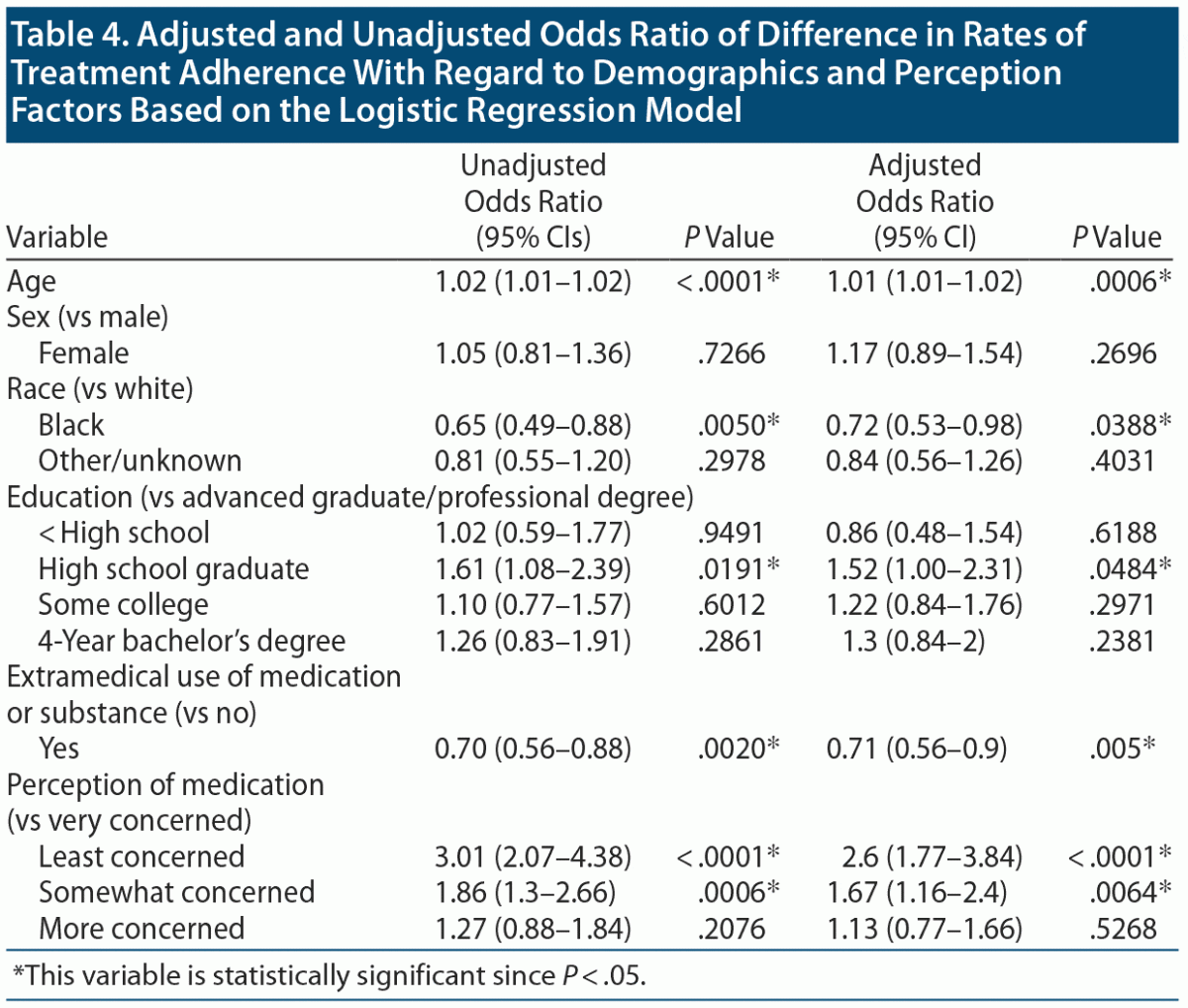Objective: Nonadherence to pharmacotherapy for psychiatric conditions is associated with poor outcomes, including increased risk of relapse, increased health care costs, and reduced quality of life. The objective of this study was to investigate the strength of association between socioeconomic factors, race/ethnicity, and patient perceptions with medication adherence in individuals with depression.
Methods: Baseline surveys were sent out in 2012 to 4,216 adult patients within a large health system who presented with a clinical diagnosis of major depressive disorder (ICD-9), recorded at least twice in the electronic medical record in the year 2011. A total of 1,573 patients responded to the baseline survey. Of those, 1,209 patients who completed the survey and had used antidepressants in the last 12 months were recruited for the study. Perception of medication risk was assessed using the Beliefs About Medicines Questionnaire, and adherence to medications was assessed using the Morisky Medication Adherence Scale. Logistic regression was used to investigate the relationship between perception of medicine risk and treatment adherence.
Results: For non-Hispanic white individuals, medication adherence was higher among those who were least concerned about the risk of medications (64%; 95% CI, 58-70) compared to those who were most concerned (34%; 95% CI, 26-43). In the logistic regression model, less concern about medications and their side effects was associated with higher medication adherence (odds ratio = 2.6; 95% CI, 1.77-3.84; P < .0001). This association remained significant after adjustment for age, race, education level, and extramedical use of other medications or substances. Moreover, patients with older age and lower education level as well as those who were non-Hispanic white and had no extramedical use of other medications/substances were more likely to be adherent to medications.
Conclusions: This study contributes quantitative data on factors that impact treatment adherence. Identifying patients at increased risk of nonadherence, having discussions with patients early in the treatment process to understand their concerns regarding treatment options, being sensitive to cultural beliefs, and patiently proceeding with the decision-making process could help ensure better outcomes.
Abstract
Objective: Nonadherence to pharmacotherapy for psychiatric conditions is associated with poor outcomes, including increased risk of relapse, increased health care costs, and reduced quality of life. The objective of this study was to investigate the strength of association between socioeconomic factors, race/ethnicity, and patient perceptions with medication adherence in individuals with depression.
Methods: Baseline surveys were sent out in 2012 to 4,216 adult patients within a large health system who presented with a clinical diagnosis of major depressive disorder (ICD-9), recorded at least twice in the electronic medical record in the year 2011. A total of 1,573 patients responded to the baseline survey. Of those, 1,209 patients who completed the survey and had used antidepressants in the last 12 months were recruited for the study. Perception of medication risk was assessed using the Beliefs About Medicines Questionnaire, and adherence to medications was assessed using the Morisky Medication Adherence Scale. Logistic regression was used to investigate the relationship between perception of medicine risk and treatment adherence.
Results: For non-Hispanic white individuals, medication adherence was higher among those who were least concerned about the risk of medications (64%; 95% CI, 58-70) compared to those who were most concerned (34%; 95% CI, 26-43). In the logistic regression model, less concern about medications and their side effects was associated with higher medication adherence (odds ratio = 2.6; 95% CI, 1.77-3.84; P < .0001). This association remained significant after adjustment for age, race, education level, and extramedical use of other medications or substances. Moreover, patients with older age and lower education level as well as those who were non-Hispanic white and had no extramedical use of other medications/substances were more likely to be adherent to medications.
Conclusions: This study contributes quantitative data on factors that impact treatment adherence. Identifying patients at increased risk of nonadherence, having discussions with patients early in the treatment process to understand their concerns regarding treatment options, being sensitive to cultural beliefs, and patiently proceeding with the decision-making process could help ensure better outcomes.
Prim Care Companion CNS Disord 2020;22(6):20m02625
To cite: Chawa MS, Yeh HH, Gautam M, et al. The impact of socioeconomic status, race/ethnicity, and patient perceptions on medication adherence in depression treatment. Prim Care Companion CNS Disord. 2020;22(6):20m02625.
To share: https://doi.org/10.4088/PCC.20m02625
© Copyright 2020 Physicians Postgraduate Press, Inc.
aDepartment of Psychiatry, Henry Ford Hospital/Wayne State University, Detroit, Michigan
bCenter for Health Policy and Health Services Research, Henry Ford Hospital, Detroit, Michigan
cCenter for Health Policy and Health Services Research and Behavioral Health Services, Henry Ford Hospital, Detroit, Michigan
*Corresponding author: Mansi Sethi Chawa, MD, Department of Psychiatry, Henry Ford Health System, 1 Ford Place, Detroit, MI 48202 ([email protected]).
Depression is a leading cause of disability and contributes significantly to the global burden of disease.1 It causes significant functional impairment and is a leading cause of reduced productivity at work.2 Antidepressants are commonly prescribed medications and are effective for treatment of conditions such as depression, anxiety, and other psychiatric disorders.3 According to clinical research,4 despite the availability of effective treatments, adherence rates are quite unsatisfactory. Nonadherence to antidepressants leads to poor clinical outcomes including increased rates of suicide, increased rates of emergency department visits, higher rates of admission to inpatient psychiatric hospitals, and worsening severity of depression.5,6 Worsening depression resulting from poor medication compliance further lowers rates of treatment adherence.7
Previous studies8 have reported that rates of nonadherence are up to 3 times greater in patients with depression compared to other conditions. Nonadherence to treatment for depression may lead to worsening severity of other chronic nonpsychiatric conditions as well. A retrospective analysis9 of patients with prior history of stroke who had concurrent depression reported increased mortality rates for those who had poor adherence to antidepressants. Furthermore, it has been shown that nonadherence to treatment can lead to higher readmission rates, which in turn increases the economic burden.5 In a study by Beeler et al,10 it was observed that patients who had comorbid depression along with other medical conditions had increased length of stay and higher rates of readmission compared to those who did not have depression.
According to the ascertaining barriers to compliance model, nonadherence can be classified into 3 categories: (1) noninitiation, which refers to failure to fill the first prescription at the pharmacy; (2) suboptimal implementation, which indicates failure to comply with the treatment regimen and take medications as prescribed; and (3) nonpersistence, which refers to premature termination of treatment.11 Rates of adherence to antidepressants have been studied. Per estimates from a previous study,12 more than one-third of patients discontinued antidepressants before the recommended duration of treatment. In another study by Sansone and Sansone,13 it was observed that almost 50% of patients prematurely terminated treatment. Available literature14 suggests multiple possible risk factors for nonadherence to treatment including sociodemographic variables, medical comorbidities, physician-patient relationship, side effects from medications, misconceptions regarding treatment, and lack of clear instructions and follow-up. The purpose of this study was to assess the relationship of factors such as age, sex, race, education level, and perception of treatment with treatment adherence in patients with depression.
METHODS
This cross-sectional study included patients who presented for treatment to clinical providers at the Henry Ford Health System. The study was supported by grants from the Fund for Henry Ford Hospital and was approved by the institutional review board at same institution.
Settings and Subjects
Baseline surveys were sent out in the year 2012 to 4,216 adult patients who were members of the health plan at the Henry Ford Health System and presented with a clinical diagnosis of major depressive disorder (ICD-9), recorded at least twice in the electronic health record in the year 2011. A total of 1,573 patients responded to the baseline survey. Of those, 1,209 patients who completed the survey and had used antidepressants in the last 12 months were recruited for the study.
Data and Instruments
Eligible patients received self-report questionnaires regarding sociodemographic characteristics such as age, sex, race (classified into 3 main categories including black, non-Hispanic white, and other/unknown), and education level (classified into 5 categories: < high school, high school graduate, some college, 4-year bachelor’s degree, and advanced graduate/professional degree). We also collected data regarding extramedical use of other medications or substances (including sedatives, tranquilizers, prescription pain relievers, stimulants, marijuana, cocaine, hallucinogens, inhalants, and heroin). Subjective medication adherence was assessed using the Morisky Medication Adherence Scale,15 which assesses the extent to which patients adhere to physician treatment recommendations. It is one of the most widely used scales to assess medication adherence. This scale was originally developed as a 4-item scale with “yes” or “no” responses to questions. Questions on the scale are as follows: (1) Do you ever forget to take your medicine? (2) Are you careless at times about taking your medicine? (3) When you feel better, do you sometimes stop taking your medicine? and (4) Sometimes if you feel worse when you take the medicine, do you stop taking it? Patients respond “yes” or “no” to each of the 4 items; “yes” responses are scored as 0 and “no” responses as 1. Higher sores indicate increased likelihood of medication adherence among patients. This scale is widely used in clinical settings given its high reliability and validity, especially with regard to treatment of chronic conditions.16 If all items were answered no, the variable of adherence was coded as yes. Otherwise, this variable was coded as no.
Perception of medications was assessed using the Beliefs About Medicines Questionnaire (BMQ).17,18 The BMQ helps to assess perceived necessity and concerns about medications and can be used to assess patients’ willingness versus reluctance to take medications.17 The BMQ has 2 subsections: general (which assesses ideas regarding medications in general) and specific (pertaining to specific disease conditions). This scale has been validated and used in various clinical settings.18
Items on the BMQ are rated on a 5-point scale (responses are graded from 1 to 5 wherein 1 implies that patients completely disagree and 5 implies that they completely agree). In our survey, we included 3 questions from the BMQ and coded them with numbers ranging from 1 to 5. The items that we utilized were as follows: “Having to take medications worries me,” “I sometimes worry about the long-term effects of my medications,” and “I sometimes worry about becoming too dependent on my medications.” Patients rate the responses to these items as strongly agree (coded as 1), disagree (coded as 2), uncertain (coded as 3), agree (coded as 4), and strongly agree (coded as 5). Total score ranged from 3 to 15. Data were divided into 4 quartiles. A total score of ≤ equal to 6 (first quantile of the sample) was rated as being “least concerned” about medications, a score ≤ 10 (median of the sample) was rated as “somewhat concerned,” a score ≤ 12 (third quantile of the sample) was rated as “more concerned,” and a score > 12 was rated as “very concerned.”
Analysis
Logistic regression was used to investigate the relationship between perception of medicine risk and treatment adherence. Treatment adherence was coded as a dichotomous variable, with “yes” or “no” outcomes indicating medication adherence in patients. The “no” outcome was used as the reference group, and the odds ratios (ORs) of independent variables described the probability of being adherent to medication treatment. The univariate and multivariate models are described in more detail in the Results section. The multivariate model for medication adherence was adjusted for age, sex, race, educational level, and extramedical use of other medications or substances. The factors adjusted in the multivariate model were those that could possibly modify the association between perception of medications and treatment adherence per the existing literature.17,19 A total of 90 patients with missing data for the independent variables were omitted from the analysis. All analyses were performed using SAS 9.4 (SAS Institute, Inc, Cary, North Carolina).
RESULTS
A total of 1,209 patients (907 women and 302 men) were included in the study. Demographic characteristics of the study population are shown in Table 1. The mean age of patients who were adherent to treatment was approximately 58 years versus 54 years for those who were nonadherent. Overall, 47.89% of patients were adherent to antidepressants, among them, 75.65% were non-Hispanic white, 15.54% were black, and 8.81% were categorized as other/unknown.
Table 2 shows the proportion of patients who were adherent to antidepressants given their level of perception of medications and race/ethnicity. Among non-Hispanic whites, individuals who were least concerned about the risk of medications were more adherent (64%; 95% CI, 0.58–0.70) compared to those who were very concerned (34%; 95% CI, 0.26–0.43). However, no such association was found among black individuals.
Table 3 shows the distribution of total scores on the Morisky Medication Adherence Scale among all patients. On the basis of their scores on this scale, 579 patients (48%) were noted to be adherent to antidepressant medications.
Table 3 shows the distribution of total scores on the BMQ. It was observed that 80 patients (6.6%) were least concerned and 82 patients (6.8%) were very concerned about medication treatment according to BMQ scores.
Table 4 shows results using the logistic regression model. In the univariate model, it was observed that least concern about medications and their side effects was associated with greater medication adherence (OR = 3.01; 95% CI, 2.07–4.38; P < .0001). We also found that older patients were more likely to be adherent to the medication treatment (OR = 1.02; 95% CI, 1.01–1.02; P < .0001). On the other hand, blacks (OR = 0.65; 95% CI, 0.49–0.88; P = .005) and patients who had a history of extramedical use or substance use (OR = 0.70; 95% CI, 0.56–0.88; P = .002) were less likely to be adherent to the medication treatment.
In the multivariate model, the association between perception of medication and medication adherence remained significant after adjustment for age, race, education level, and extramedical use of other medications or substances (adjusted OR = 2.6; 95% CI, 1.77–3.84; P < .0001). We also observed that blacks were less likely to be adherent to medication treatment compared to non-Hispanic whites (adjusted OR = 0.72; 95% CI, 0.53–0.98; P = .03). Extramedical use of other medications or substances was associated with a decreased adherence to medication treatment (adjusted OR = 0.71; 95% CI, 0.56–0.9; P = .005). Moreover, patients who were high school graduates were more likely to be adherent to treatment compared to those with advanced graduate/professional degrees (adjusted OR = 1.52; 95% CI, 1.00–2.31; P = .04). There was no difference in rates of adherence between men and women (P = .26).
DISCUSSION
This study contributes quantitative data on patient demographic and perception factors that impact adherence to pharmacotherapy in the treatment of depression. We observed that rates of treatment adherence were lower in younger patients, blacks, and patients using other medications or illicit substances. No differences were noted in men versus women in terms of medication adherence. We also observed that favorable treatment perception contributes to significantly higher rates of adherence to medications irrespective of other demographic factors.
Comparison With Existing Literature
In our study population, 52.1% of patients were nonadherent to treatment with antidepressants. Prior studies14 have shown antidepressant nonadherence rates to be between 13% and 55.7%. However, even higher rates of nonadherence have been reported, with 1 study20 finding that only 25%–50% of patients were adherent to treatment with antidepressants. There are various factors that increase the risk of noncompliance to treatment, including social and demographic factors, treatment-related concerns, and patient-physician interactions.4 In this study, we looked at various factors that can increase risk of medication noncompliance among patients with depression. One significant finding from our study regards the impact of treatment perception on compliance. Patients’ beliefs and perceptions significantly impact adherence to treatment.21 Prejudices against treatment with medications and disbelief in their potential to prevent relapse lead to poor compliance.22 According to the theory of the health belief model, beliefs and attitudes significantly impact treatment adherence,23 and this holds true for other medical conditions as well. In a recent study24 of patients with chronic noncancer pain, it was observed that concerns regarding medications and their side effects were associated with underuse of medications and presence of side effects. In our study, we observed that, overall, less concern about medications and their side effects was associated with higher medication adherence, and this association remained significant after adjustment for age, race, education level, and use of other medications or substances. This finding is consistent with what previous studies25,26 have reported regarding perception of treatment and the impact on adherence. Given that treatment perception impacts adherence rates independent of the nonmodifiable demographic factors, use of strategies such as strengthening therapeutic alliance, devoting ample time to patients, assessing treatment adherence regularly, motivating patients to take medications, and assessing any potential barriers to compliance with treatment are important to improve rates of treatment adherence.27
As mentioned previously, demographic and social factors can also significantly impact treatment compliance. In this study, we observed that older age was associated with higher rates of adherence to treatment. Previous studies28,29 have reported similar results. Older adults tend to have a higher number of comorbid medical conditions, and one would expect that this would lead to lower rates of treatment adherence. However, as reported in a study by Rossom et al,29 having a higher number of comorbid medical conditions was associated with better compliance to treatment with antidepressants. It is possible that patients with other medical comorbidities become accustomed to managing more medications on a regular basis and are more aware of the harmful effects of discontinuing treatment.29 Conversely, as people age, compliance to treatment may decline due to worsening cognitive functioning, increased sensitivity to medication side effects, and drug interactions resulting from polypharmacy.12 Per results from a previous study,12 patients aged 60–69 years were more adherent to treatment with antidepressants than those who were older. Ayalon et al30 also reported that cognitive impairment was associated with significantly reduced rates of treatment adherence.
With regard to sex, we found no significant difference in the rate of treatment adherence between men and women. Conflicting results regarding association of sex with treatment adherence have been reported. Our results were similar to those of a Swedish longitudinal study31 that found no significant overall differences in the rates of treatment adherence between male and female patients. Other studies have reported sex differences in relation to treatment compliance. In a study by Sundell et al,32 women were noted to have lower rates of early discontinuation of treatment, whereas in another study from Iceland,33 men were noted to have higher medication adherence compared to women. Given evidence in the literature, sex is an inconclusive predictor of treatment adherence.
Another significant finding from our study was that lower education level was associated with higher rates of treatment adherence. The results were significant particularly when comparing patients who were high school graduates with those who were college graduates. This finding is contrary to that of previous studies.31,34 In a study by Olfson et al,34 it was observed that patients who had less than 12 years of education had lower rates of treatment adherence. One may expect that patients with lower education level would have less health literacy, which would in turn lead to lower rates of treatment adherence.35 One possible explanation for these results could be that patients with lower education level tend to be more accepting of their providers’ recommendations, thus leading to improved compliance.36
On the basis of the literature, the impact of race/ethnicity on compliance to treatment appears to be one of the strongest predictors of treatment adherence.4 In our study, non-Hispanic whites had higher rates of treatment adherence compared to blacks. Furthermore, among the non-Hispanic white individuals, medication adherence was higher in those who were least concerned about the risk of medications compared to those who are most concerned. We found no such association among black patients. Taking into account the existing literature, these racial differences could be due to multiple sociocultural factors. Minority races are prone to having concerns with regard to trusting the health care system and health care professionals. They may have different belief systems about diseases and their treatment and may possibly perceive racism and bias by mental health professionals and institutions at increased rates.37 Furthermore, racial minorities, including blacks and Hispanics, are more likely to choose psychotherapy and prayer over antidepressants. Minority races are also less likely to believe that depression has a biological basis,38 which is particularly important in day-to-day practice for treatment providers. Shared decision making is vital to patient-centered care.39 A successful treatment outcome not only depends on the medical expertise of the provider but also involves taking into account patients’ goals, preferences, and backgrounds. Previous studies40 have reported that patients who report increased levels of shared decision making have overall better treatment outcomes in terms of adherence and satisfaction with care, as well as better emotional health and shorter hospital stays. An established patient-provider relationship can help reshape the attitudes and beliefs of patients, help foster better understanding of their roles in the treatment process, facilitate active involvement in the treatment process, and help improve compliance. With regard to depression, given the chronic nature of this condition, a multifaceted approach incorporating educational, behavioral, and provider-targeted strategies needs to be employed to ensure better compliance. Previous research41 has shown that interventions focusing only on education might not be sufficient to improve compliance. Increasing frequency of follow-ups, integrating mental health specialists into primary care settings, providing more collaboration between primary care physicians and mental health providers, and involving other allied health care specialties such as nursing, social workers, and pharmacists can help improve adherence to treatment and ensure improved treatment outcomes.42
These findings highlight the importance of being sensitive to the different cultural practices, values, and belief systems of our patients and engaging them in a shared decision-making process. In this way, health care providers can ensure the best possible treatment for their patients, which can help improve their overall well-being and quality of life.
Another important finding from our study was that extramedical use of other medications or substances was associated with lower rates of treatment adherence. Similar results were reported by other studies.43,44 Substance abuse is a predictor of noncompliance with treatment in other psychiatric conditions as well. In a study45 of patients who were diagnosed with schizophrenia, use of alcohol at baseline was associated with lower rates of treatment adherence. Timely interventions in the form of screening for substance use disorders and encouraging patients to seek treatment can help improve adherence to psychotropic medications, leading to better outcomes of other psychiatric conditions as well.
A strength of our study is that we included a large number of patients from diverse socioeconomic backgrounds, which helped in analyzing the correlation of various demographic and cultural factors with treatment adherence. Our study has several limitations. Due to the study’s naturalistic design, we were reliant on clinician diagnosis of psychiatric conditions. Various factors that can also influence treatment adherence, such as physician-patient relationship and patient satisfaction, could not be assessed. We also were unable to assess reasons for medication discontinuation, including medication side effects, insurance issues, and concerns with transportation. We used validated subjective measures of adherence to treatment; however, use of objective measures such as pill count and pharmacy data could have provided more precise information. Previous research46 has shown that subjective measures such as self-report questionnaires are easier to use and correlate well with objective measure of adherence to treatment. Since baseline surveys to collect data were sent out in 2012, it is possible that the demographic characteristics of the population have changed over the last 8 years.
Another limitation was that all patients in the study belonged to one major metropolitan city, were recruited from a single large health care system, and had insurance. All of these factors could limit generalizability of the results.
CONCLUSION
This study helps in understanding various risk factors that could impact adherence to treatment with psychotropic medications in patients with depression. We found that younger age, black race, and use of other medications or illicit substances were associated with lower rates of treatment adherence. Another significant finding from this study was that favorable treatment perception contributes to significantly higher rates of adherence to treatment with psychotropic medications irrespective of all other nonmodifiable demographic factors stated above. This is an interesting finding since it highlights the importance of having discussions with patients early in the treatment process to understand their concerns regarding treatment options, as well as being sensitive to their cultural beliefs and patiently proceeding with the decision-making process, which could lead to increased adherence rates and better treatment outcomes. Further studies looking at the impact of implementing these strategies on treatment outcomes in patients with depression can help confirm this hypothesis.
Submitted: March 30, 2020; accepted June 26, 2020.
Published online: December 10, 2020.
Potential conflicts of interest: None.
Funding/support: This study was supported by a grant from the Fund for Henry Ford Hospital.
Role of the sponsor: The content is solely the responsibility of the authors and does not necessarily represent the official views of Henry Ford Hospital. All authors have contributed to and have approved the final submitted manuscript.
Clinical Points
- Younger age, black race, and use of other medications or illicit substances were associated with lower rates of treatment adherence.
- Favorable treatment perception contributes to significantly higher rates of adherence to treatment with psychotropic medications.
- Discussions with patients early in the treatment process to understand concerns, as well as being sensitive to cultural beliefs and patiently proceeding with the decision-making process, could lead to increased treatment adherence rates and better outcomes.
REFERENCES
1. World Health Organization. Investing in Mental Health. Geneva, Switzerland: World Health Organization; 2003.
2. Donohue JM, Pincus HA. Reducing the societal burden of depression: a review of economic costs, quality of care and effects of treatment. Pharmacoeconomics. 2007;25(1):7–24. PubMed CrossRef
3. Gardarsdottir H, Heerdink ER, van Dijk L, et al. Indications for antidepressant drug prescribing in general practice in the Netherlands. J Affect Disord. 2007;98(1–2):109–115. PubMed CrossRef
4. Rivero-Santana A, Perestelo-Perez L, Pérez-Ramos J, et al. Sociodemographic and clinical predictors of compliance with antidepressants for depressive disorders: systematic review of observational studies. Patient Prefer Adherence. 2013;7:151–169. PubMed
5. Ho SC, Chong HY, Chaiyakunapruk N, et al. Clinical and economic impact of non-adherence to antidepressants in major depressive disorder: a systematic review. J Affect Disord. 2016;193:1–10. PubMed CrossRef
6. Henein F, Prabhakar D, Peterson EL, et al. A prospective study of antidepressant adherence and suicidal ideation among adults. Prim Care Companion CNS Disord. 2016;18(6):16l01935. PubMed
7. Vlasnik JJ, Aliotta SL, DeLor B. Medication adherence: factors influencing compliance with prescribed medication plans. Case Manager. 2005;16(2):47–51. PubMed CrossRef
8. DiMatteo MR, Lepper HS, Croghan TW. Depression is a risk factor for noncompliance with medical treatment: meta-analysis of the effects of anxiety and depression on patient adherence. Arch Intern Med. 2000;160(14):2101–2107. PubMed CrossRef
9. Krivoy A, Stubbs B, Balicer RD, et al. Low adherence to antidepressants is associated with increased mortality following stroke: a large nationally representative cohort study. Eur Neuropsychopharmacol. 2017;27(10):970–976. PubMed CrossRef
10. Beeler PE, Cheetham M, Held U, et al. Depression is independently associated with increased length of stay and readmissions in multimorbid inpatients. Eur J Intern Med. 2020;73:59–66. PubMed CrossRef
11. Vrijens B, De Geest S, Hughes DA, et al; ABC Project Team. A new taxonomy for describing and defining adherence to medications. Br J Clin Pharmacol. 2012;73(5):691–705. PubMed CrossRef
12. Holvast F, Oude Voshaar RC, Wouters H, et al. Non-adherence to antidepressants among older patients with depression: a longitudinal cohort study in primary care. Fam Pract. 2019;36(1):12–20. PubMed CrossRef
13. Sansone RA, Sansone LA. Antidepressant adherence: are patients taking their medications? Innov Clin Neurosci. 2012;9(5-6):41–46. PubMed
14. Hung CI. Factors predicting adherence to antidepressant treatment. Curr Opin Psychiatry. 2014;27(5):344–349. PubMed CrossRef
15. Morisky DE, Green LW, Levine DM. Concurrent and predictive validity of a self-reported measure of medication adherence. Med Care. 1986;24(1):67–74. PubMed CrossRef
16. Uchmanowicz B, Jankowska EA, Uchmanowicz I, et al. Self-reported medication adherence measured with Morisky Medication Adherence Scales and its determinants in hypertensive patients aged ≥60 years: a systematic review and meta-analysis. Front Pharmacol. 2019;10:168. PubMed CrossRef
17. Horne R, Weinman J. Patients’ beliefs about prescribed medicines and their role in adherence to treatment in chronic physical illness. J Psychosom Res. 1999;47(6):555–567. PubMed CrossRef
18. Jimenez K, Vargas C, Garcia K, et al. Evaluating the validity and reliability of the Beliefs About Medicines Questionnaire in low-income, Spanish-speaking patients with diabetes in the United States. Diabetes Educ. 2017;43(1):114–124. PubMed CrossRef
19. Gagnon MD, Waltermaurer E, Martin A, et al. Patient beliefs have a greater impact than barriers on medication adherence in a community health center. J Am Board Fam Med. 2017;30(3):331–336. PubMed CrossRef
20. Trivedi MH, Lin EH, Katon WJ. Consensus recommendations for improving adherence, self-management, and outcomes in patients with depression. CNS Spectr. 2007;12(suppl 13):1–27. PubMed
21. Horne R, Chapman SC, Parham R, et al. Understanding patients’ adherence-related beliefs about medicines prescribed for long-term conditions: a meta-analytic review of the Necessity-Concerns Framework. PLoS One. 2013;8(12):e80633. PubMed CrossRef
22. Prakash J, Yadav YK, Srivastava K, et al. Psychosocial correlates of medication adherence in patients with depressive illness. Ind Psychiatry J. 2019;28(1):135–140. PubMed CrossRef
23. Sripad P, Kirk K, Adoyi G, et al. Exploring survivor perceptions of pre-eclampsia and eclampsia in Nigeria through the health belief model. BMC Pregnancy Childbirth. 2019;19(1):431. PubMed CrossRef
24. Timmerman L, Stronks DL, Huygen FJ. The relation between patients’ beliefs about pain medication, medication adherence, and treatment outcome in chronic pain patients: a prospective study. Clin J Pain. 2019;35(12):941–947. PubMed CrossRef
25. Edlund MJ, Fortney JC, Reaves CM, et al. Beliefs about depression and depression treatment among depressed veterans. Med Care. 2008;46(6):581–589. PubMed CrossRef
26. Brown C, Battista DR, Bruehlman R, et al. Beliefs about antidepressant medications in primary care patients: relationship to self-reported adherence. Med Care. 2005;43(12):1203–1207. PubMed CrossRef
27. Julius RJ, Novitsky MA Jr, Dubin WR. Medication adherence: a review of the literature and implications for clinical practice. J Psychiatr Pract. 2009;15(1):34–44. PubMed CrossRef
28. Sirey JA, Bruce ML, Alexopoulos GS, et al. Stigma as a barrier to recovery: Perceived stigma and patient-rated severity of illness as predictors of antidepressant drug adherence. Psychiatr Serv. 2001;52(12):1615–1620. PubMed CrossRef
29. Rossom RC, Shortreed S, Coleman KJ, et al. Antidepressant adherence across diverse populations and healthcare settings. Depress Anxiety. 2016;33(8):765–774. PubMed CrossRef
30. Ayalon L, Areán PA, Alvidrez J. Adherence to antidepressant medications in black and Latino elderly patients. Am J Geriatr Psychiatry. 2005;13(7):572–580. PubMed CrossRef
31. Mårdby AC, Schiöler L, Sundell KA, et al. Adherence to antidepressants among women and men described with trajectory models: a Swedish longitudinal study. Eur J Clin Pharmacol. 2016;72(11):1381–1389. PubMed CrossRef
32. Sundell KA, Waern M, Petzold M, et al. Socio-economic determinants of early discontinuation of anti-depressant treatment in young adults. Eur J Public Health. 2013;23(3):433–440. PubMed CrossRef
33. Tómasson K, Tómasson H, Zoëga T, et al. Epidemiology of psychotropic medication use: comparison of sales, prescriptions and survey data in Iceland. Nord J Psychiatry. 2007;61(6):471–478. PubMed CrossRef
34. Olfson M, Marcus SC, Tedeschi M, et al. Continuity of antidepressant treatment for adults with depression in the United States. Am J Psychiatry. 2006;163(1):101–108. PubMed CrossRef
35. Townsend MS. Patient-driven education materials: low-literate adults increase understanding of health messages and improve compliance. Nurs Clin North Am. 2011;46(3):367–378, vii–viii. PubMed CrossRef
36. Jin J, Sklar GE, Min Sen Oh V, et al. Factors affecting therapeutic compliance: a review from the patient’s perspective. Ther Clin Risk Manag. 2008;4(1):269–286. PubMed
37. Jimenez DE, Bartels SJ, Cardenas V, et al. Cultural beliefs and mental health treatment preferences of ethnically diverse older adult consumers in primary care. Am J Geriatr Psychiatry. 2012;20(6):533–542. PubMed CrossRef
38. Givens JL, Houston TK, Van Voorhees BW, et al. Ethnicity and preferences for depression treatment. Gen Hosp Psychiatry. 2007;29(3):182–191. PubMed CrossRef
39. Montori VM, Gafni A, Charles C. A shared treatment decision-making approach between patients with chronic conditions and their clinicians: the case of diabetes. Health Expect. 2006;9(1):25–36. PubMed CrossRef
40. Joosten EA, DeFuentes-Merillas L, de Weert GH, et al. Systematic review of the effects of shared decision-making on patient satisfaction, treatment adherence and health status. Psychother Psychosom. 2008;77(4):219–226. PubMed CrossRef
41. Akerblad AC, Bengtsson F, Ekselius L, et al. Effects of an educational compliance enhancement programme and therapeutic drug monitoring on treatment adherence in depressed patients managed by general practitioners. Int Clin Psychopharmacol. 2003;18(6):347–354. PubMed CrossRef
42. Chong WW, Aslani P, Chen TF. Effectiveness of interventions to improve antidepressant medication adherence: a systematic review. Int J Clin Pract. 2011;65(9):954–975. PubMed CrossRef
43. Pfeiffer PN, Ganoczy D, Zivin K, et al. Benzodiazepines and adequacy of initial antidepressant treatment for depression. J Clin Psychopharmacol. 2011;31(3):360–364. PubMed CrossRef
44. Akincigil A, Bowblis JR, Levin C, et al. Adherence to antidepressant treatment among privately insured patients diagnosed with depression. Med Care. 2007;45(4):363–369. PubMed CrossRef
45. Kamali M, Kelly BD, Clarke M, et al. A prospective evaluation of adherence to medication in first episode schizophrenia. Eur Psychiatry. 2006;21(1):29–33. PubMed CrossRef
46. Myers ED, Calvert EJ. Information, compliance and side-effects: a study of patients on antidepressant medication. Br J Clin Pharmacol. 1984;17(1):21–25. PubMed CrossRef
Please sign in or purchase this PDF for $40.00.









